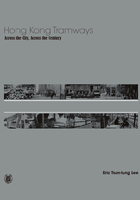
Early Tram Style, Operation and Charges
Hong Kong Tramways had 26 first-batch tramcars, which were all known as the "first-generation trams". All these tramcars were of single deck and made in England. The components were shipped to Hong Kong from England before they were assembled in Hong Kong.
These single-deck tramcars were all painted maroon with doors and window frames in white. Some tramcars had louvres on the roofs for convection. As the tram system was operated by bidirectional monorail, both the front and the rear of tramcars had driver's cabs.

The first-generation third-class tram drove past Shau Kei Wan.
Initially, trams were divided into two categories – first-class and third-class tramcars. There were ten first-class tramcars and 16 third-class tramcars. The first class tramcar was enclosed in the centre with two long benches on both sides. Both the front and the back ends were open. Seating capacity was 32 passengers. The third-class tramcars were open-sided with no side panels but six sets of benches running through the middle, back to back, seating 48 passengers. The first-class tram fare was 10 cents, while that for third-class was 5 cents.

Technical drawing of the first-generation first-class tram.

First-generation tramcar with single-deck design in 1906. The background was Alexandra House in Central.

Two third-class trams drove past the landmark Kwong Tung Hotel in Shek Tong Tsui. One can see the open-sided tram cars.

Technical drawing of the first-generation third-class tram.

A tram was converted into a oats in the parade celebrating King George V's ascension to the throne in 1911.
According to the records, the initial operation of tram service was not smooth. As tram was a brand new thing, when it arrived at a stop, the public would rush on board bustling, making the tram unable to depart on time. On the other hand, as the tramway was smoother than other parts of the road, in order to save energy, coolies liked to push their freight trolleys on tramways, seriously affecting the tram operation. In view of this, the government passed legislation in 1911 to prohibit anyone from using the tramway with carriages, cars or vehicles having flange-wheels or other wheels suitable to run on the rails of the tramway, or they shall be liable to a fine of $100. This legislation is still in force.